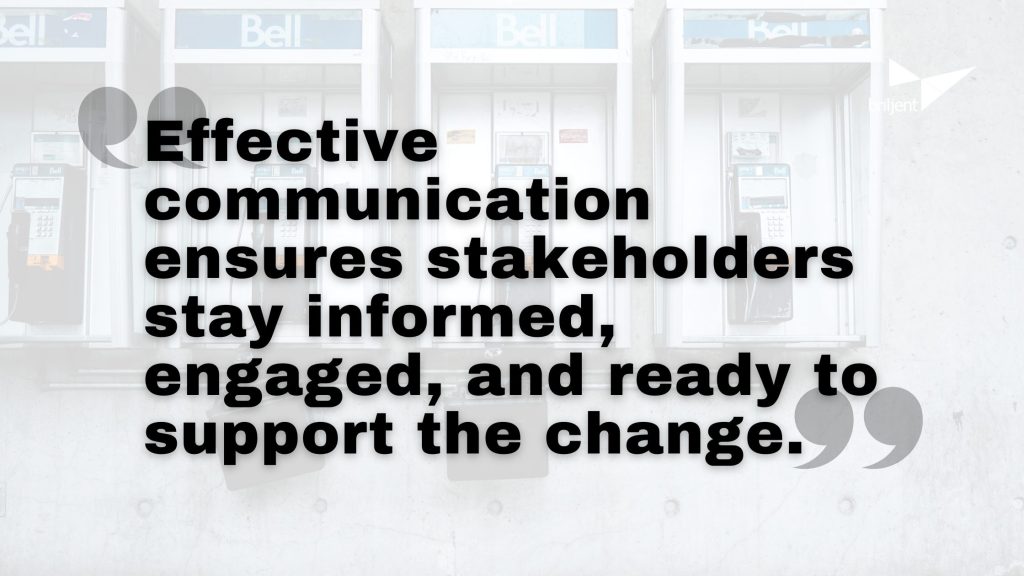Summary
Discover the art of communication in system modernization. Learn how effective communication planning can transform your organizational change management efforts.
Introduction
Hey there! Today, we’re diving into a crucial topic for anyone involved in system modernization: communication planning in Organizational Change Management (OCM). Whether you’re leading an agency, serving in an executive role at an organization, project managing a system implementation, or just someone interested in OCM for your development, this post is for you. We’ll explore why communication planning is essential, the common challenges faced, and some practical strategies to overcome them.
But first, this post is part of a series on OCM for system modernization. Feel free to check out the Introduction, Organizational Readiness, or Stakeholder Management.
Okay, let’s dive in!
Communication plays a pivotal role in OCM by ensuring that stakeholders are aware of the change, understand its benefits, and are motivated to support it.
Organizational Change Management (OCM) helps individuals and teams adopt new ways of working. Communication is central—it ensures people are informed, aligned, and ready to support the change. (For a deeper dive into how OCM supports modernization, see our post, “From Confusion to Cohesion: How OCM Enhances System Modernization.”)
Consider a complex software rollout: without clear communication, teams may miss updates, stakeholders might misinterpret goals, and users could resist adoption. A thoughtful communication plan reduces these risks and supports success.
The Importance of Communication Planning
So, why is communication planning so crucial in OCM? Well, imagine trying to implement a major change without keeping everyone on the same page. One team communicates only with their department, your project sponsor only engages with leadership, the design team focuses on system features, but managers want to know what process changes are required. No one knows exactly who to go to for the most relevant and timely information. The project feels disjointed, and staff are getting frustrated. Does this sound familiar? Chaos, right?
Effective communication ensures stakeholders stay informed, engaged, and ready to support the change. When done right, it leads to increased stakeholder engagement, improved project outcomes, and reduced risk of project delays and disruptions.
Key Components of a Communication Plan
Think of a well-crafted communication plan as your roadmap for a road trip. It sets out your communication goals (your destination), identifies who you’re talking to (your travel buddies), and creates clear, consistent messages (what everyone needs to know). These messages are tailored to different audiences (what you tell the driver vs. what you tell the navigator). The plan also picks the best communication channels (text your friends when you’re getting close) and schedules messages for maximum impact (don’t tell me which exit to take until we’re five miles away). With a solid plan, everyone knows where you’re headed and how you’ll get there.
Strategies for Effective Communication in System Modernization
Engaging stakeholders is key to successful communication. Regular updates, interactive sessions, and opportunities for feedback help build support and ensure that concerns are addressed. Transparency is also crucial; being open and honest about the change process, its challenges, and its progress builds trust and credibility. Also, methods for receiving and incorporating feedback, like surveys and focus groups, help identify areas for improvement and ensure that stakeholders feel heard when they see their feedback incorporated in new iterations of the plan.
Adaptability is essential; being flexible and responsive to changing circumstances and stakeholder needs ensures that the communication plan remains effective throughout the change process.

Tools and Resources
When it comes to communication planning in OCM, having the right tools can make all the difference. Here are some of my top picks:
- Project Management Software: Tools like Jira and Trello are fantastic for keeping track of tasks and progress. They provide a visual representation of the project’s status, making it easier for everyone to stay aligned.
- Collaboration Tools: Platforms such as Slack and Microsoft Teams are essential for real-time communication. Create dedicated channels for different stakeholder groups to ensure tailored updates and focused discussions.
- Data Visualization Tools: Tableau is a great option for visualizing data and sharing insights with your team. It helps in making complex information more digestible and actionable.
- Interactive Webinars and Workshops: Hosting sessions through Zoom can offer stakeholders the opportunity to ask questions and provide feedback in real-time. This interactive approach fosters engagement and ensures that everyone feels heard.
Industry reports, best practice guides, and online courses on OCM and communication planning can be valuable resources for further reading and learning. At Briljent, we pride ourselves on being technology-agnostic, allowing us to partner on communication planning and OCM projects with the flexibility to discuss and implement the right tool at the right time for the right partner.
Discussion Prompt
How have you successfully navigated communication challenges in your own projects? Share your experiences and strategies in the comments below!
Conclusion
To wrap things up, effective communication planning is essential for successful organizational change management in system modernization projects. It ensures stakeholders are informed, engaged, and supportive of the change process. Organizations can navigate change more effectively by prioritizing clear, consistent, and transparent communication. Implementing these strategies in your projects will help achieve successful outcomes and build strong stakeholder relationships.
Have a complex message to deliver to a multi-stakeholder audience? We’d love to brainstorm with you to get you started on a plan. Drop us a line.


